A Holistic Approach to Enhance the Use of Neglected and Underutilized Species: The Case of Andean Grains in Bolivia and Peru
Abstract
:1. Introduction
2. Experimental Section
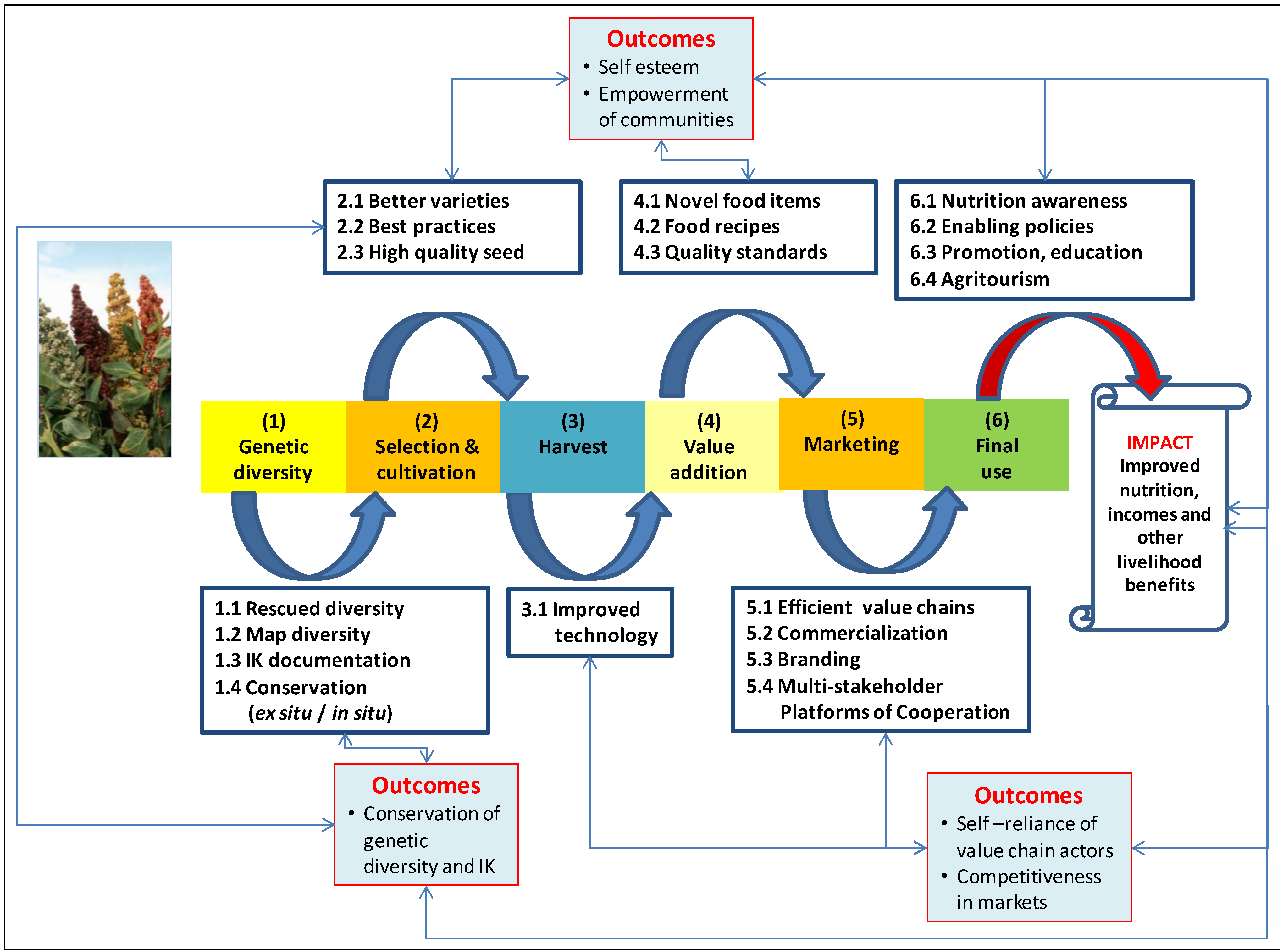
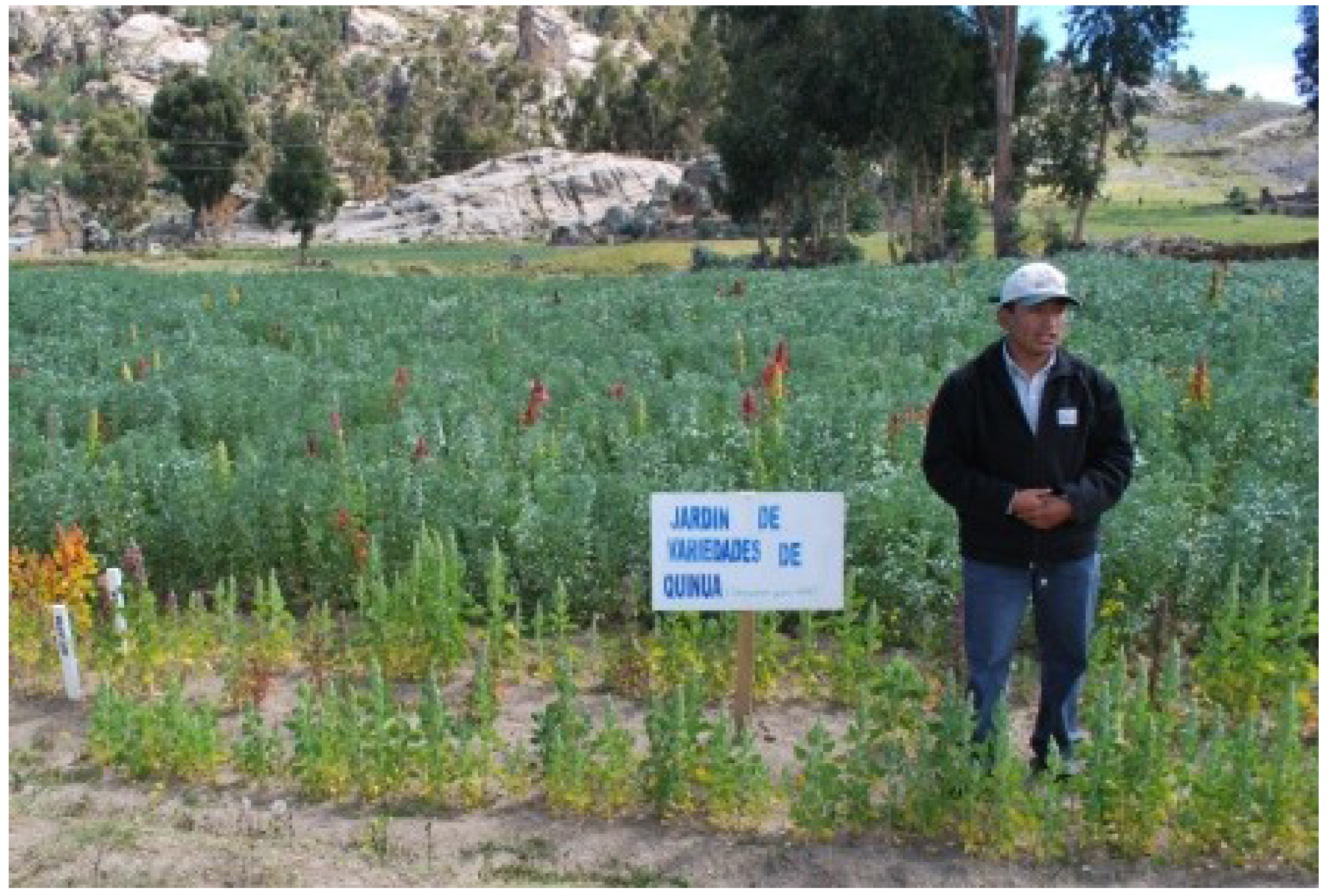
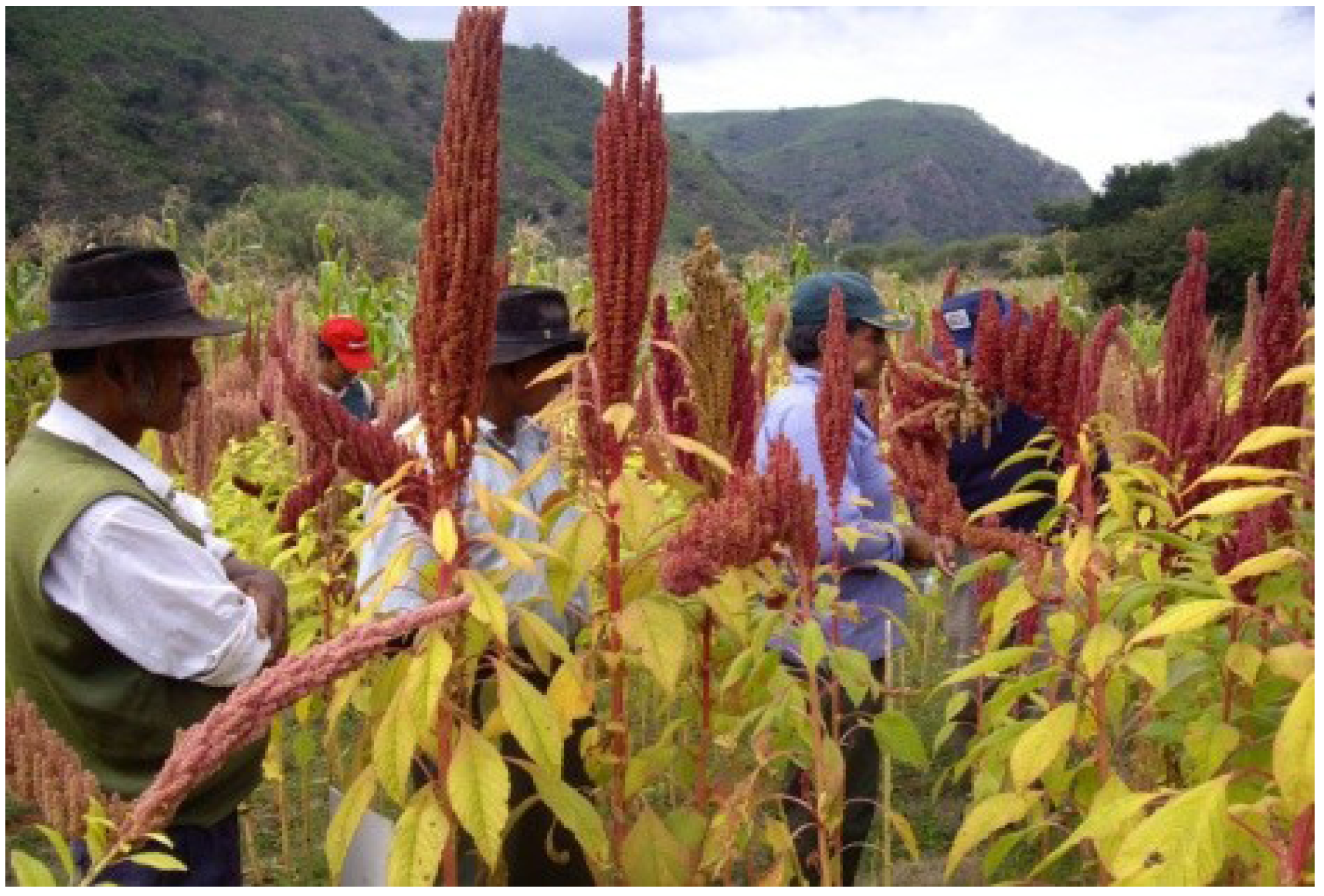
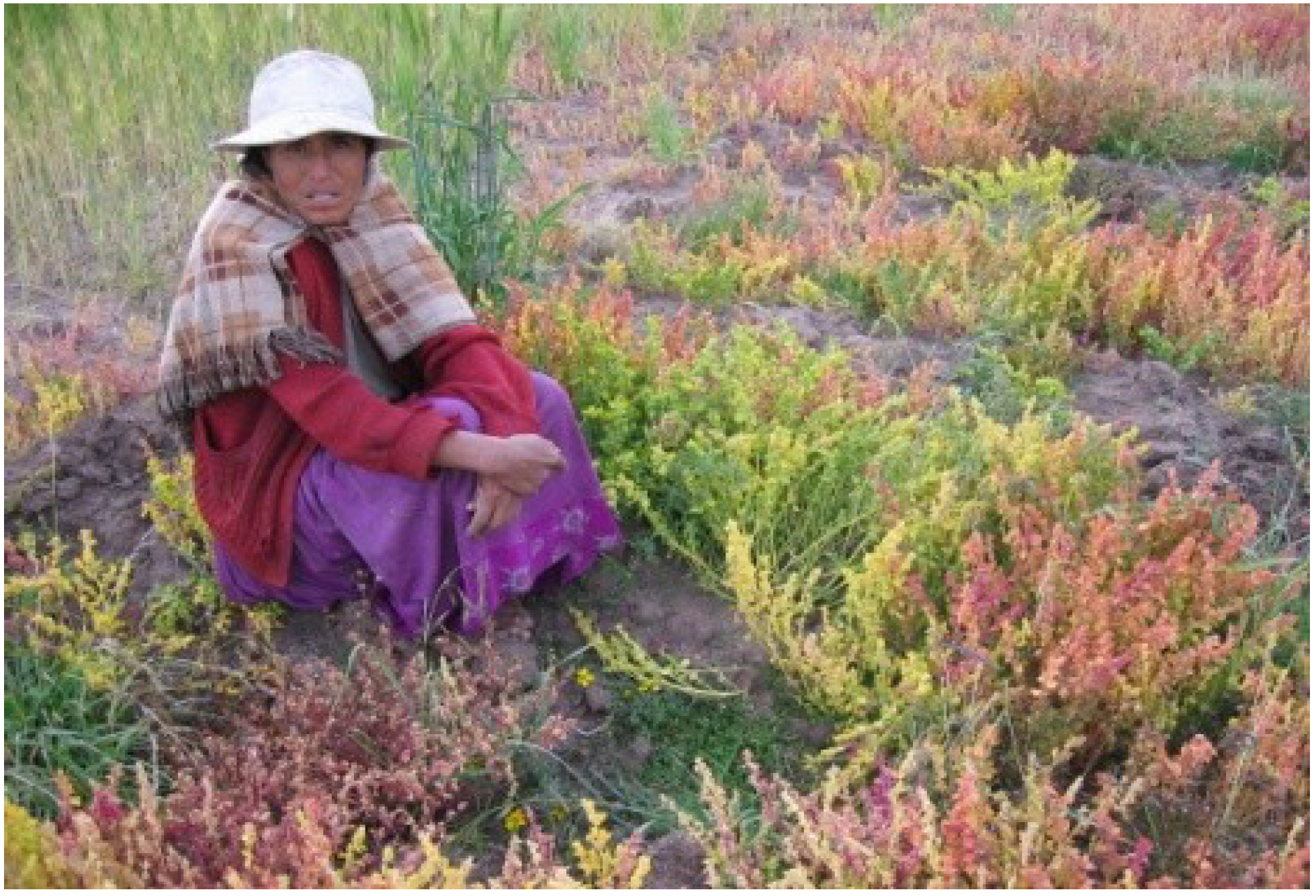
3. Results and Discussion
| Value chain segment | Crop | ||
|---|---|---|---|
| Quinoa | Amaranth | Cañahua | |
| Genetic diversity |
| ||
|
|
| |
| Selection, cultivation, harvest and post-harvest |
| ||
|
|
| |
| Value addition |
| ||
|
|
| |
| Marketing |
| ||
|
|
| |
| Capacity building, education and public awareness |
| ||
3.1. Genetic Diversity
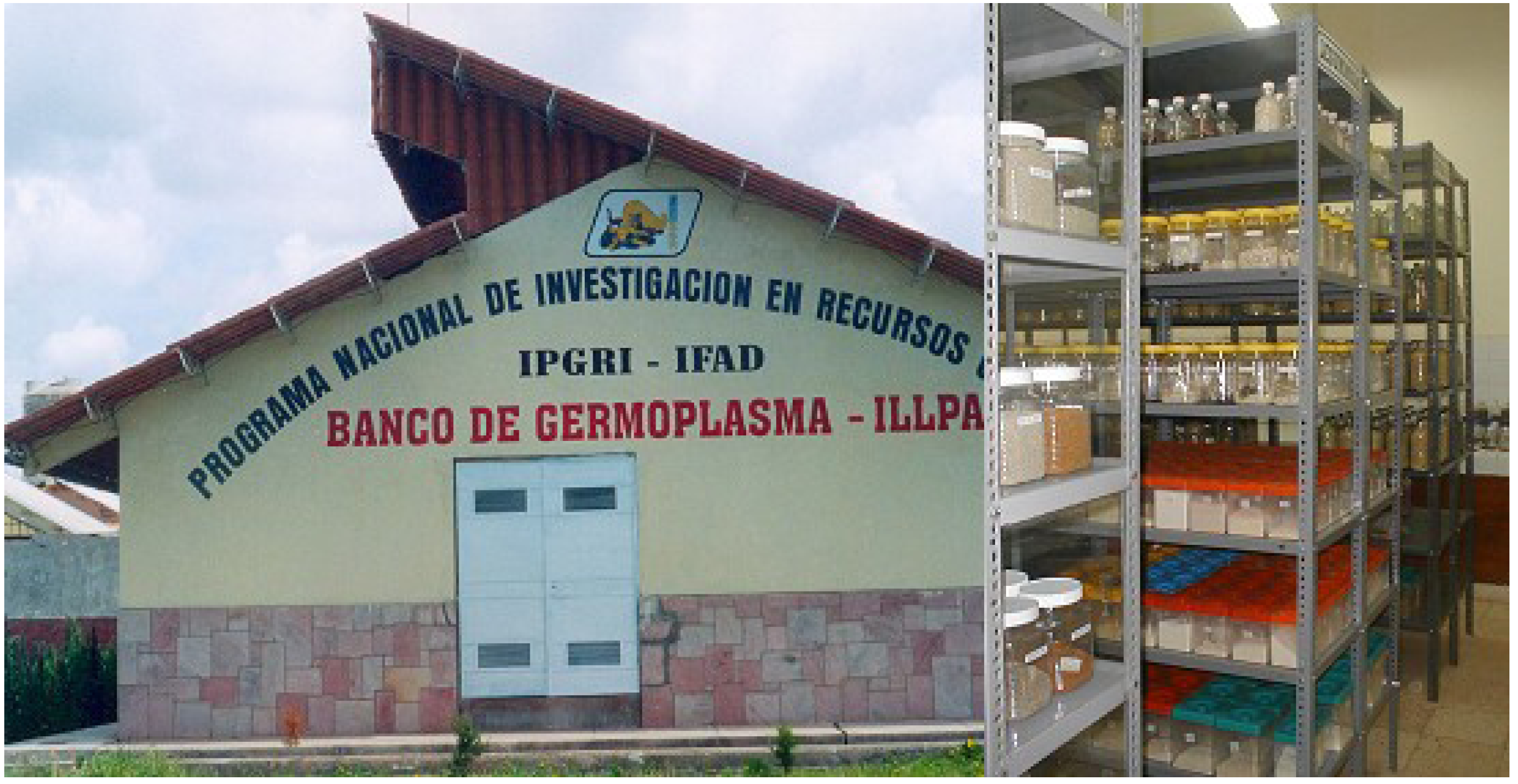
| Product category | Food preparations recorded during the Fairs | |||
|---|---|---|---|---|
| 2002 | 2003 | 2004 | ||
| Beverages | Quinoa drink | Quinoa drink; Cañahua drink | Quinoa drink; | Quinoa with milk; Cañahua drink |
| “Kusa de quinua”; | ||||
| “Api” | ||||
| Soups and other savoury products | “P’esque de quinua”; Quinoa soup | Quinoa in grains; “Torrejas de quinua”; “P’esque de quinua”; Quinoa soup | P’esque with milk; | P’esque with cañahua; “P’esque con ahugado”; “Saise de quinua”; Meatballs; “Plato a la huancaina” “Muchacha”; “Lawa de cañahua” |
| “Jupha tanta”; | ||||
| “ Segundo de quinua”; | ||||
| “Pesque huracha”; | ||||
| “Pisara”; | ||||
| Quinoa soup; | ||||
| “Lawa (allpi)”; | ||||
| “Huaricha” | ||||
| Pastries | “Pito de quinua”; “Kispiña” | “
Kispiña de quinua”; “Tayacha de cañahua”; “Pito de quinua” | “Pito de cañahua”; | “Jupha kispiña”; “K’api kispiña”; “Piri”; “Mukuna”; “Wila quispiña”; “Cañahua omelette”; “Buñuelo de cañahua”; Cañahua cake; Cañahua cookies Quinoa cookies |
| “Q’api kispiña” | ||||
| “K'iqui kispiña”; | ||||
| “Acu kispiña”; | ||||
| “Kispiña”; | ||||
| “Kispiña de ajara”; | ||||
| Quinoa cake; | ||||
| Quinoa omelette; | ||||
| “Buñuelos de quinua”; | ||||
| “Kispiña tostada” | ||||

3.2. Selection, Cultivation, Harvest and Post Harvest
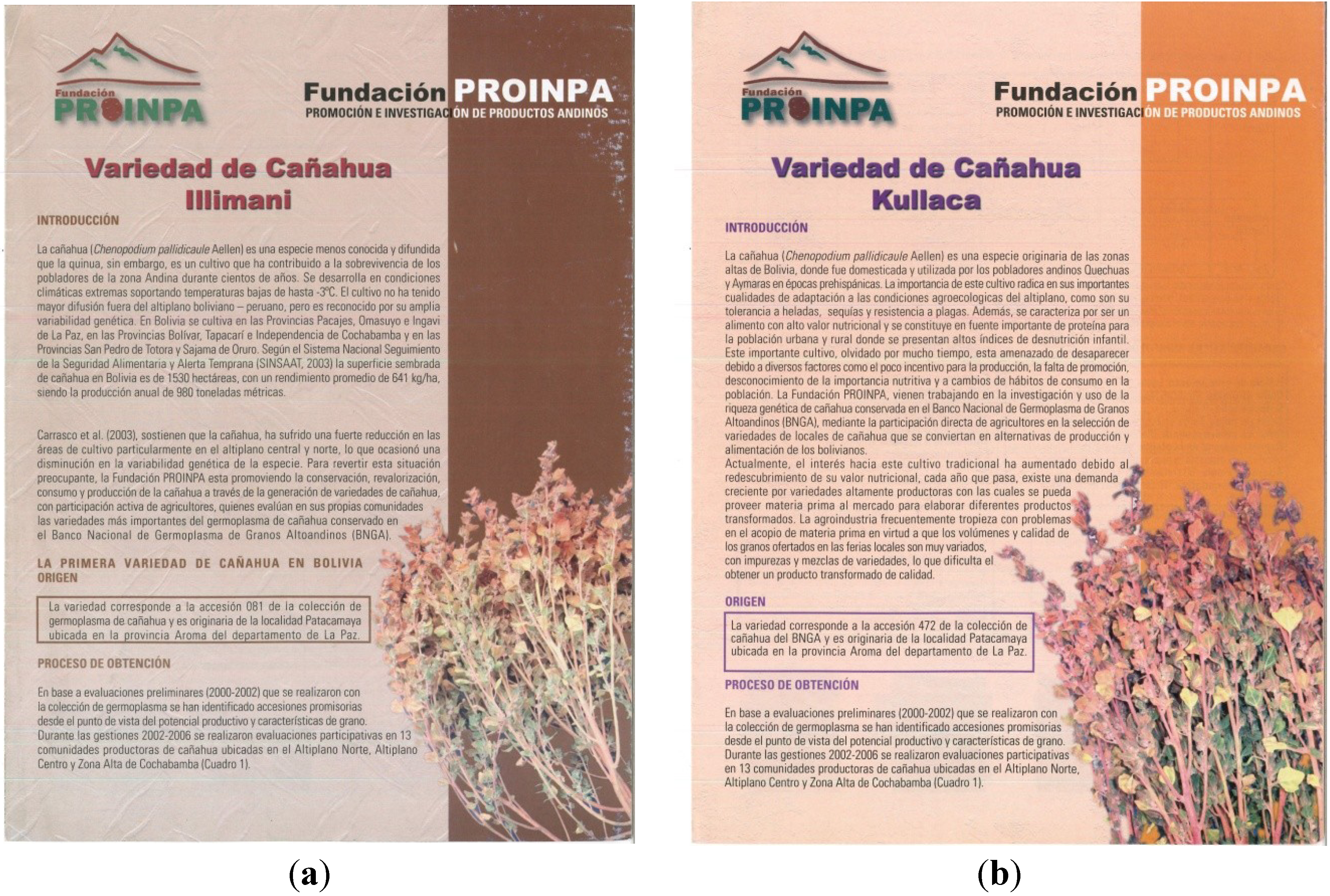
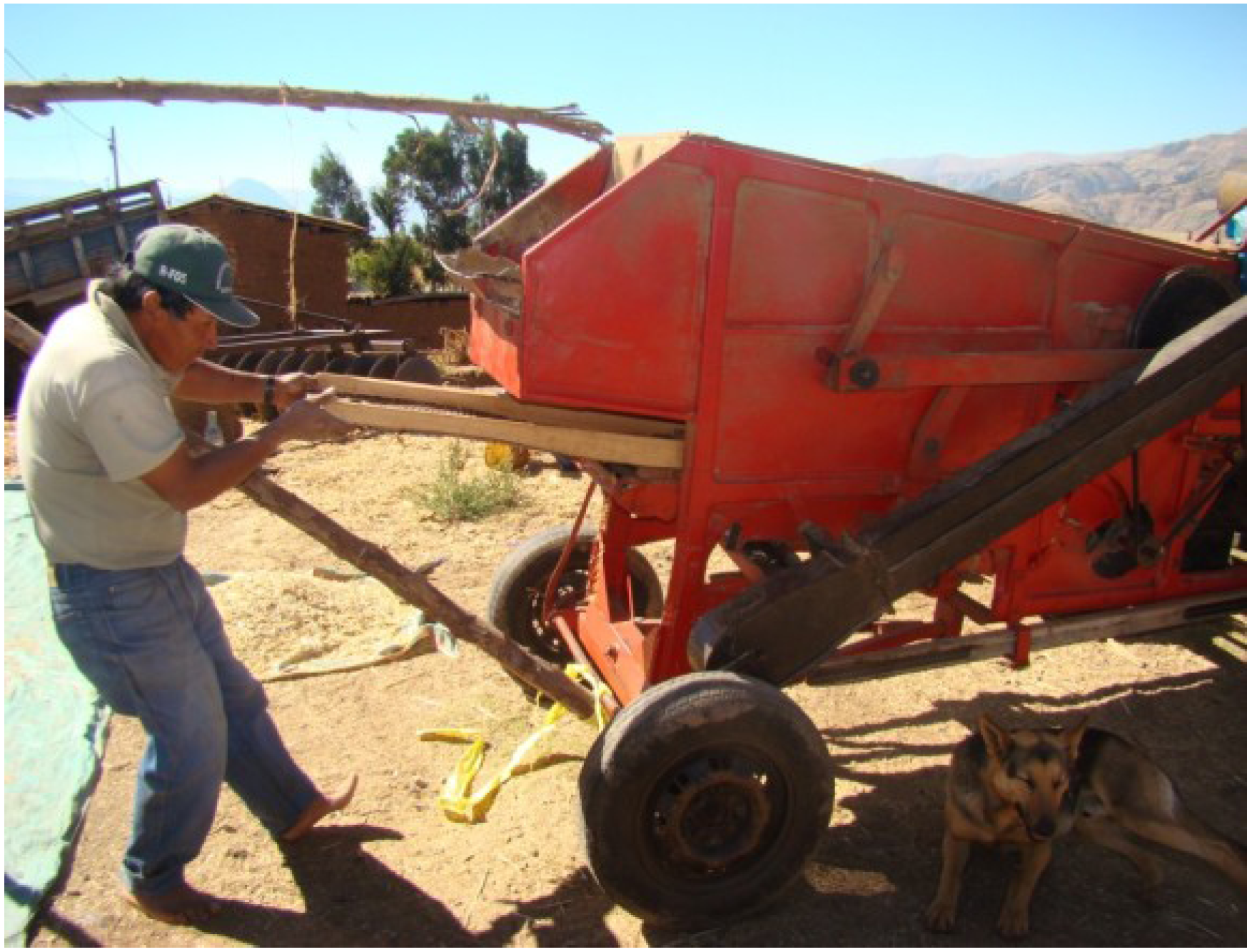
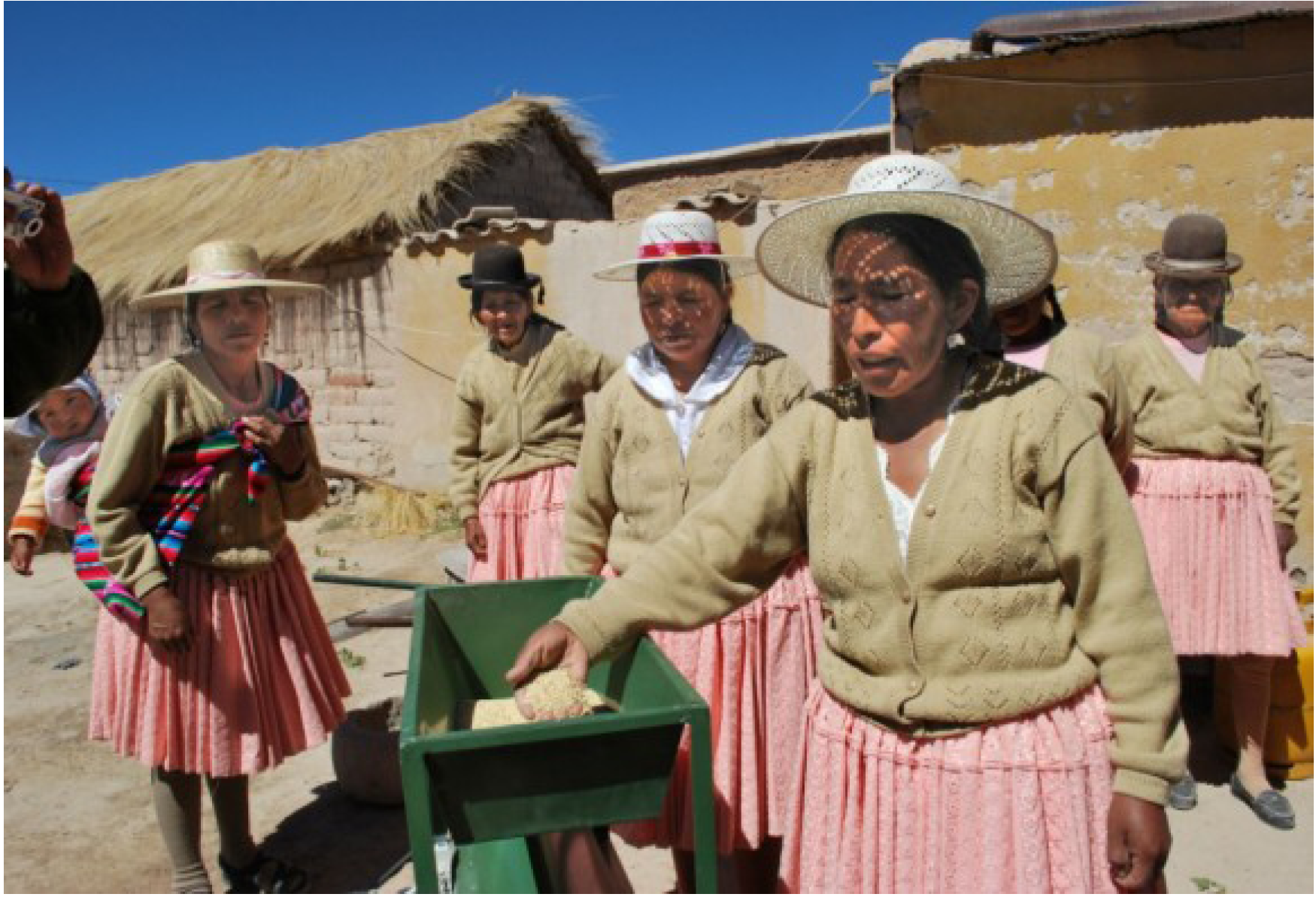
3.3. Value Addition
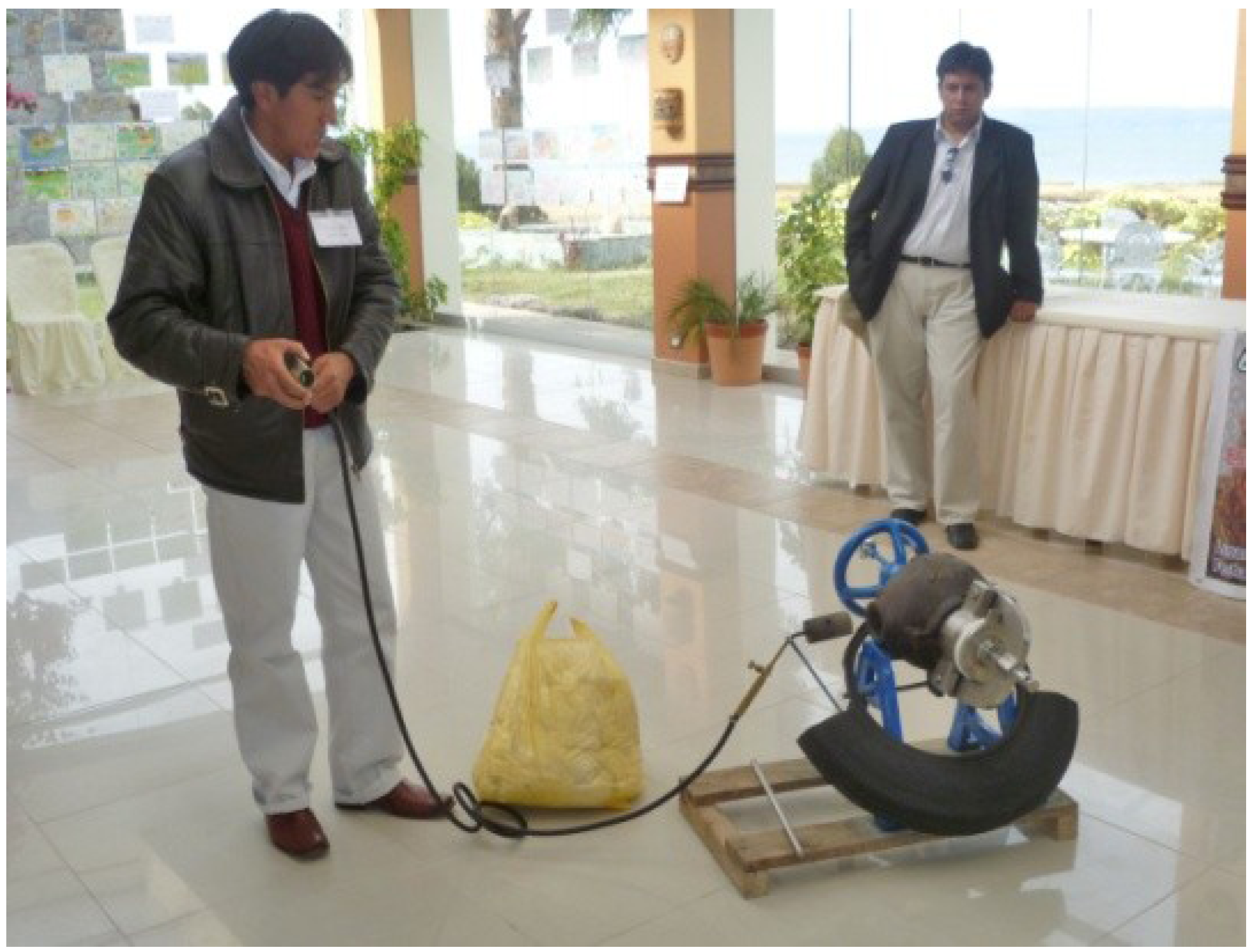
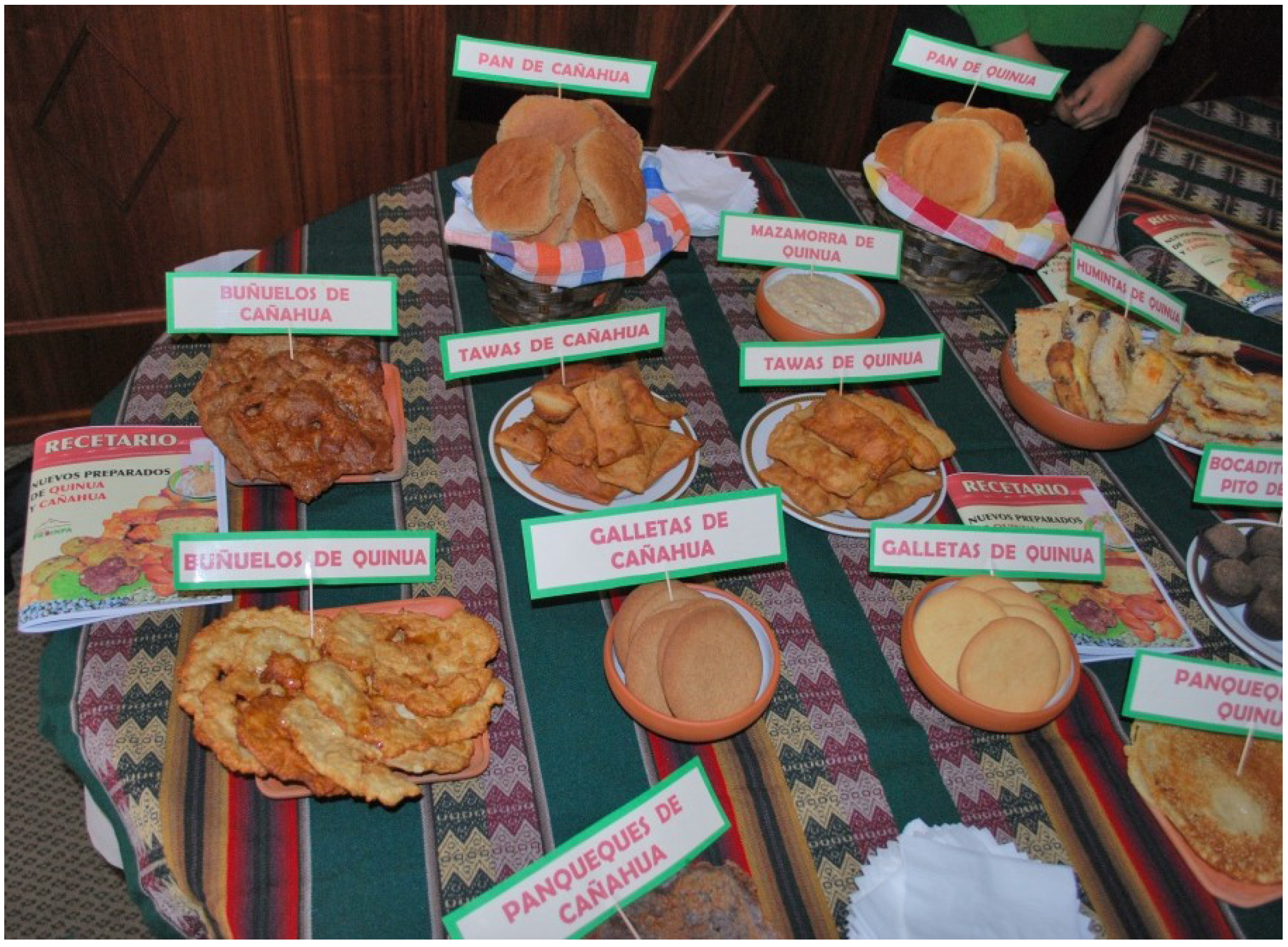
| Variable | Quinoa | Cañihua | Amaranth | Barley | Wheat | Maize |
|---|---|---|---|---|---|---|
| Carbohydrates (g/100 g) | 67–70 ● | 65–68.4 * | 65.1 ● | 58.32 * | 78.4 ♦♦ | 81.1 ♦♦ |
| Raw fibre (g/100 g) | 3.1–7 ● | 5.1–5.7 * | 6.7 ● | 9.4–10.2 ● | 3 ** | 9.2 ** |
| Fat (g/100 g) | 8.9–12.9 * | 3.5–5 ● | 7.2 ● | 6.15 * | 2.3 ♦♦ | 4.7 ♦♦ |
| Proteins (g/100 g) | 15–15.8 * | 13.9–16.8 * | 12.9 ● | 12.6 * | 14.3 ♦♦ | 10.2 ♦♦ |
| Calcium (mg/100 g) | 80–124 ● | 125.8–195.4 * | 179 ● | 20 ●● | 50.3 ♦♦ | 17.1 ♦♦ |
| Iron (mg/100 g) | 3.6–6.5 * | 16.7–41.3 * | 5.3 ● | 3 ●● | 3.8 ♦♦ | 2.1 ♦♦ |
| Essential amino acids (% per g of protein): | ||||||
| Isoleucine | 6.88–7.05 ● | 5.8–6.84 ● | 5.17–6.17 ● | 3.2 ♦ | 3.2 ♦ | 3.2 ♦ |
| Leucine | 10.4 ♦ | 5.44–6.08 ● | 4.23–5.2 ● | 6.3 ♦ | 6.0 ♦ | 10.3 ♦ |
| Lysine | 7.9 ♦ | 5.07–6.28 ● | 6.43–7.16 ● | 2.4 ♦ | 1.5 ♦ | 2.7 ♦ |
| Phenylalanine | 5.9 ♦ | 3.18–3.72 ● | 3.27–3.98 ● | 3.7 ♦ | 3.4 ♦ | 3.3 ♦ |
| Methionine | 1.98–2.2 ● | 1.4–1.71 ● | 2.13–2.45 ● | 1.3 ♦ | 1.0 ♦ | 1.6 ♦ |
| Threonine | 4.5–4.52 ● | 4.41–4.89 ● | 4.73–5.38 ● | 3.2 ♦ | 2.7 ♦ | 3.9 ♦ |
| Tryptophan | 1.6 ♦ | 0.74–0.85 ● | 0.95–1.21 ● | 1.1 ♦ | 0.6 ♦ | 0.5 ♦ |
| Valine | 7.6 ♦ | 4.25–4.72 ● | 4.36–4.61 ● | 4.6 ♦ | 3.7 ♦ | 4.9 ♦ |
3.4. Marketing
- Participatory mapping of relevant actors and their function within the value chain;
- Joint assessment of existing constraints and bottlenecks;
- Development of upgrading strategies, action plans, up-scaling tools and methodologies;
- Expansion of impact of the project beyond its project sites;
- Promotion of synergy and trust building among value chain actors (farmers, transformers, and researchers) and local governments for sharing knowledge;
- Strengthening horizontal and vertical linkages;
- Dissemination of good agricultural and post-harvest practices and innovative technology, for more efficient value chains.

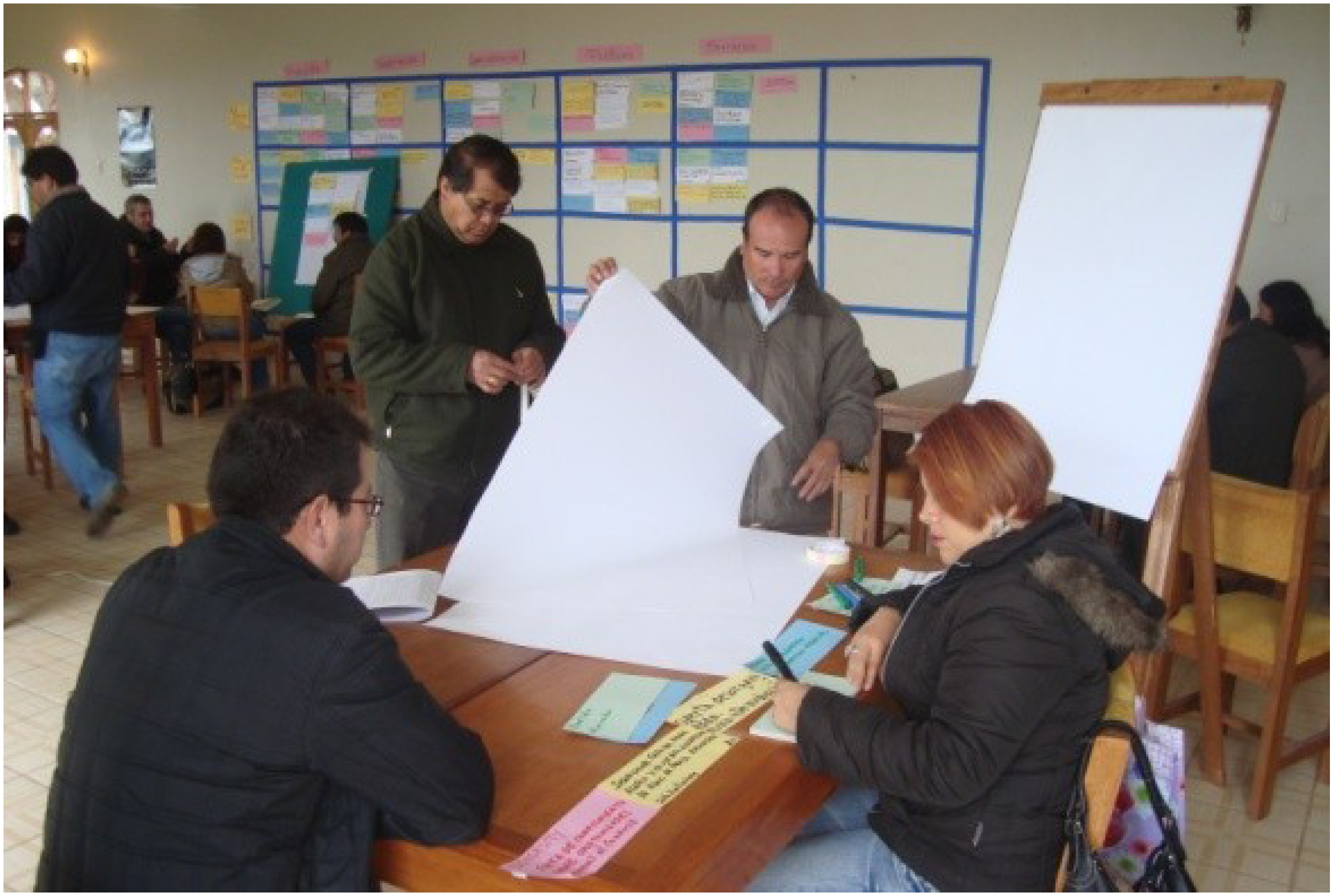
3.5. Education, Public Awareness and Capacity Building
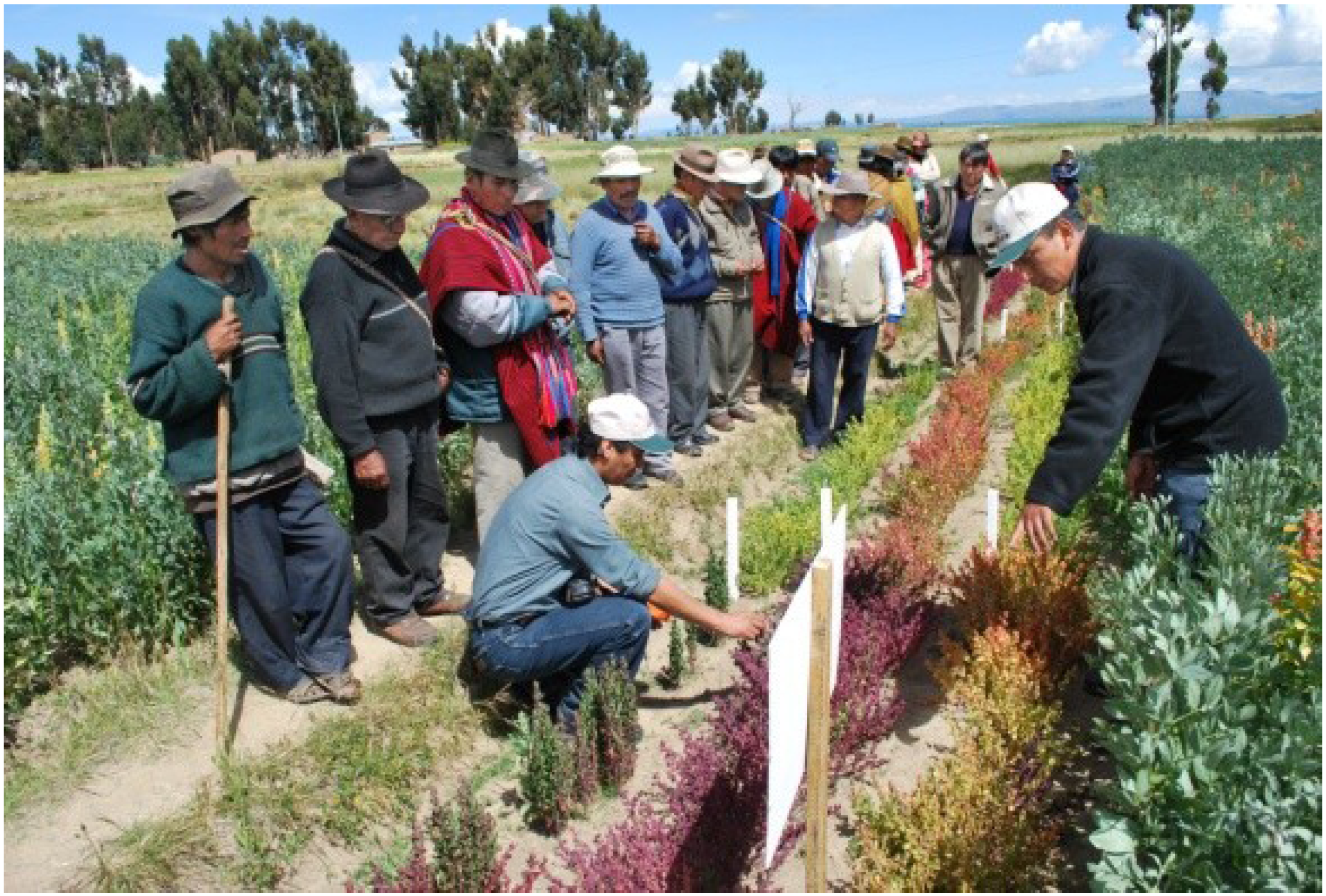
3.6. Outcomes and Impact

| Indicators | Phase 1 only ** | Phase 2 only * | Both Phase 1 and 2 ** | |||||
|---|---|---|---|---|---|---|---|---|
| Bolivia | Peru | Bolivia | Peru | Bolivia | Peru | |||
| EL | EL | |||||||
| Andean grain adoption | ||||||||
| Area planted to AG | 247.961 | 41.384 | ||||||
| Number of native AG varieties planted | 0.257 | 1.062 | 0.981 | |||||
| Number of introduced AG varieties | 0.217 | 0.218 | 0.122 | 1.216 | 0.908 | |||
| Perceived marketability of AG (ranked as a 5-item ordinal scale) | 0.665 | 0.415 | ||||||
| Consumption frequency of AG (ranked on a 6-item ordinal scale) | 0.018 | 0.218 | 0.007 | 0.163 | 0.643 | 1.585 | ||
| Livelihood measures | ||||||||
| Perceived income | 0.091 | 54.3 | ||||||
| Appliance index | 0.090 | 0.161 | ||||||
| Farm input index | 0.011 | |||||||
| Livestock index | 0.025 | 0.025 | ||||||
| Perceived nutrition | −0.019 | 0.389 | ||||||
4. Conclusions and Way Forward
List of Abbreviations
| AG | Andean Grains |
| BS. | Bolivianos (currency of Bolivia) |
| CGIAR | Consultative Group on International Agricultural Research |
| CIAL | Local Research Committee |
| CIRNMA | Centro de Investigación de Recursos Naturales y Medio Ambiente, Peru |
| FAO | Food and Agricultural Organization of the United Nations |
| GPA | Global Plan of Action |
| Ha | Hectare |
| IBNORCA | Bolivian Institute of Quality and Standardization |
| IFAD-NUS | International Fund for Agricultural Development (FIDA in Spanish)—Neglected and Underutilized Species |
| IK | Indigenous Knowledge |
| INDECOPI | Peruvian National Institute for the Defense of Competition and the Protection of Intellectual Property |
| INIA | Instituto Nacional de Innovación Agraria, Peru |
| NGO | Non Governmental Organization |
| NUS | Neglected and Underutilized Species |
| PGR | Plant Genetic Resources |
| PGRFA | Plant Genetic Resources for Food and Agriculture |
| PIM | Policies, Institutions and Markets |
| PROINPA | Fundación para la Promoción e Investigación de Productos Andinos, Bolivia |
| PVS | Participatory Variety Selection |
| R&D | Research and Development |
| SEGEDES | Departmental Service for Social Management, Bolivia |
| UCODEP | Unity and Cooperation for the Development of Peoples, Italy |
| UN | United Nations |
| USD | United States Dollar |
Acknowledgments
Author Contributions
Conflicts of Interest
References
- Myers, N.; Mittermeier, R.A.; Mittermeier, C.G.; da Fonseca, G.A.B.; Kent, J. Biodiversity hotspots for conservation priorities. Nature 2000, 403, 853–858. [Google Scholar] [CrossRef]
- Vavilov, N.I. The Origin, Variation, Immunity and Breeding of Cultivated Plants; The Chronica Botanica Company: Waltham, MA, USA, 1951; p. 364. [Google Scholar]
- Food and Agriculture Organization (FAO). La Quinua: Cultivo Milenario para Contribuir a la Seguridad Alimentaria Mundial; FAO, Oficina Regional para América Latina y el Caribe: La Paz, Bolivia, 2011; p. 58. (In Spanish) [Google Scholar]
- The World Bank. Shifting Gears to Accelerate Shared Prosperity in Latin America and the Caribbean. Available online: http://www.worldbank.org/content/dam/Worldbank/document/LAC/PLB%20Shared%20Prosperity%20FINAL.pdf (accessed on 28 November 2013).
- Socioeconomic Database for Latin America and the Caribbean SEDLAC. Available online: http://sedlac.econo.unlp.edu.ar/eng/statistics.php (accessed on 28 November 2013).
- Von Braun, J.; Byerlee, C.; Chartres, C.; Lumpkin, T.; Olembo, N.; Waage, J. Towards a Strategy and Results Framework for the CGIAR. Progress Report No. 4 from the Strategy Team. 2009. Available online: https://docs.google.com/viewer?a=v&pid=sites&srcid=Y2d4Y2hhbmdlLm9yZ3x hbGxpYW5jZXxneDo3ZGVmZDJjZjI5MmVkMWE (accessed on 28 November 2013).
- Jacobsen, S.E. The worldwide potential for quinoa (Chenopodium quinoa willd.). Food Rev. Int. 2003, 19, 167–177. [Google Scholar] [CrossRef]
- Jäger, M.; Valdivia, R.; Padulosi, S.; Arce, J. Lanzamiento de una Plataforma Multiactoral para Promocionar el Uso Sostenible de los Granos Andinos. In Memorias del Foro Realizado en Puno, Perú,11–13 de Noviembre de 2009; Centro de Investigación de Recursos Naturales y de Medio Ambiente (CIRNMA), Bioversity International, Agencia Suiza para el Desarrollo y la Cooperación (COSUDE): Puno, Peru, 2010; p. 36. (In Spanish) [Google Scholar]
- Carrasco, E.; Soto, J.L. Importancia de los Granos Andinos. In Granos Andinos. Avances, Logros y Experiencias Desarrolladas en Quinua, Cañahua y Amaranto en Bolivia; Rojas, W., Soto, J.L., Pinto, M., Jäger, M., Padulosi, S., Eds.; Bioversity International: Rome, Italy, 2010; pp. 6–10. (In Spanish) [Google Scholar]
- Tapia, M.E. Origen y Domesticación de las Especies Alimenticias en la Región Andina. In Cultivos Andinos Subexplotados y su Aporte a la Alimentación; FAO: Santiago, Chile, 1990; pp. 17–28. (In Spanish) [Google Scholar]
- Astudillo, D.; Aroni, G. Livelihoods of Quinoa Producers in Southern Bolivia. In Biodiversity of Andean Grains: Balancing Market Potential and Sustainable Livelihoods; Giuliani, A., Hintermann, F., Rojas, W., Padulosi, S., Eds.; Bioversity International: Rome, Italy, 2012; pp. 78–145. [Google Scholar]
- Padulosi, S.; Bala Ravi, S.; Rojas, W.; Valdivia, R.; Jager, M. Experiences and Lessons Learned in the Framework of a Global UN Effort in Support of Neglected and Underutilized Species. In Proceedings of the 2nd International Symposium on Underutilized Plant Species: Crops for the Future—Beyond Food Security; Massawe, F., Mayes, S., Alderson, P., Eds.; Acta Horticulturae: Leuven, Belgium, 2013; p. 979. [Google Scholar]
- Johns, T. Agrobiodiversity Diet and Human Health. In Managing Biodiversity in Agricultural Ecosystems; Jarvis, D.I., Padoch, C., Cooper, H.D., Eds.; Bioversity International: Rome, Italy, 2011; pp. 382–406. [Google Scholar]
- Food and Agriculture Organization (FAO). Biodiversity for a World without Hunger. Plants. Available online: http://www.fao.org/biodiversity/components/plants/en/ (accessed on 28 November 2013).
- Prescott-Allen, R.; Prescott-Allen, C. How many plants feed the world? Conserv. Biol. 1990, 4, 365–374. [Google Scholar] [CrossRef]
- World Health Organization (WHO); United Nations Children’s Funds (UNICEF); World Bank; Canadian International Development Agency; US Agency for International Development; Food and Agriculture Organization (FAO); United Nations Development Programme (UNDP). Ending Hidden Hunger. In Proceedings of the Policy Conference on Micronutrient Malnutrition, Montreal, QC, Canada, 10–12 October 1991.
- United Nations. The Millennium Development Goals Report; United Nations: New York, NY, USA, 2005. Available online: http://unstats.un.org/unsd/mi/pdf/mdg%20book.pdf (accessed on 28 November 2013).
- Biesalski, H.K. Hidden Hunger; Springer-Verlag: Berlin, Germany, 2013; p. 255. [Google Scholar]
- Food and Agriculture Organization (FAO). Global Plan of Action for the Conservation and Sustainable Utilization of Plant Genetic Resources for Food and Agriculture and the Leipzig Declaration. FAO: Leipzig, Germany, 1996; p. 63. [Google Scholar]
- Food and Agriculture Organization (FAO). The Second Global Plan of Action for the Conservation and Sustainable Utilization of Plant Genetic Resources for Food and Agriculture; Commission on Genetic Resources for Food and Agriculture, FAO: Rome, Italy, 2012; p. 91. [Google Scholar]
- Food and Agriculture Organization (FAO). The International treaty on Plant Genetic Resources for Food and Agriculture. Available online: http://ftp.fao.org/docrep/fao/011/i0510e/i0510e.pdf (accessed on 28 November 2013).
- Food and Agriculture Organization (FAO). Cordoba Declaration on Promising Crops for the XXI Century. Available online: http://www.fao.org/fileadmin/templates/food_composition/documents/Cordoba_NUS_Declaration_2012_FINAL.pdf (accessed on 28 November 2013).
- Padulosi, S.; Thompson, J.; Rudebjer, P. Fighting Poverty, Hunger and Malnutrition with Neglected and Underutilized Species (NUS): Needs, Challenges and the Way Forward; Bioversity International: Rome, Italy, 2013. [Google Scholar]
- Padulosi, S. Neglected No More. Achievements of the IFAD-NUS Project (2001–2005) and Framework for its Follow-up Initiative (2007–2009); Bioversity International: Rome, Italy, 2007; p. 19. [Google Scholar]
- Gotor, E.; Caracciolo, F.; Polar, V.; Padulosi, S.; Blundo Canto, G. Assessing the Impact of Research for Development Projects: Bioversity International Programme on Andean Grain in Bolivia and Peru; Bioversity International: Rome, Italy, 2012; p. 16. [Google Scholar]
- Mackay, R. External Evaluation IFAD NUS I Project—Asia and Latin America Components; Private Consultancy to the International Fund for Agricultural Development (IFAD): Rome, Italy, 2005; p. 43. [Google Scholar]
- Padulosi, S.; Hodgkin, T.; Williams, J.T.; Haq, N. Underutilized Crops: Trends, Challenges and Opportunities in the 21st Century. In Proceedings of the Managing Plant Genetic Diversity Proceedings of an International Conference, Kuala Lumpur, Malaysia, 120–16 June 2000; pp. 323–338.
- Padulosi, S.; Hoeschle-Zeledon, I. Underutilized plant species: What are they? LEISA 2004, 20, 5–6. [Google Scholar]
- Bravo, R.; Valdivia, R.; Andrade, K.; Padulosi, S.; Jäger, M. Granos Andinos. Avances, Logros y Experiencias Desarrolladas en Quinua, Cañihua y Kiwicha en Perú; Bioversity International: Rome, Italy, 2010; p. 127. (In Spanish) [Google Scholar]
- Granos Andinos. Avances, Logros y Experiencias Desarrolladas en Quinua, Cañahua y Amaranto en Bolivia; Rojas, W.; Soto, J.L.; Pinto, M.; Jäger, M.; Padulosi, S. (Eds.) Bioversity International: Rome, Italy, 2010; p. 178. (In Spanish)
- International Plant Genetic Resources Institute (IPGRI); Fundación para la Promoción e Investigación de Productos Andinos (Fundación PROINPA); International Fund for Agricultural Development (IFAD). Descriptores para cañahua (Chenopodium pallidicaule Aellen); International Plant Genetic Resources Institute: Rome, Italy, 2005; p. 45. (In Spanish) [Google Scholar]
- Bioversity International; The Food and Agricultural Organization of the United Nations (FAO); Fundación para la Promoción e Investigación de Productos Andinos (Fundación PROINPA); Instituto Nacional de Innovación Agropecuaria y Forestal (INIAF); Fondo Internacional de Desarrollo Agrícola (FIDA). Descriptores para quinoa (Chenopodium quinoa Willd.) y sus parientes silvestres; Bioversity International/Organización de las Naciones Unidas para la Agricultura y la Alimentación/Fondo Internacional de Desarrollo Agrícola: Roma, Italy; Fundación PROINPA/Instituto Nacional de Innovación Agropecuaria y Forestal: La Paz, Bolivia, 2013; p. 52. (In Spanish) [Google Scholar]
- Bravo, R.; Catacora, P. Situación actual de los bancos nacionales de germoplasma. In Granos Andinos. Avances, Logros y Experiencias Desarrolladas en Quinua, Cañahua y Kiwicha en Perú; Rojas, W., Bravo, R., Valdivia, R., Andrade, K., Padulosi, S., Jäger, M., Eds.; Bioversity International: Rome, Italy, 2010; pp. 15–18. (In Spanish) [Google Scholar]
- Rojas, W.; Pinto, M.; Bonifacio, A.; Gandarillas, A. Banco de Germoplasma de Granos Andinos. In Granos Andinos. Avances, Logros y Experiencias Desarrolladas en Quinua, Cañahua y Amaranto en Bolivia; Rojas, W., Soto, J.L., Pinto, M., Jäger, M., Padulosi, S., Eds.; Bioversity International: Rome, Italy, 2010; pp. 39–53. (In Spanish) [Google Scholar]
- Rojas, W.; Pinto, M. Colecta de germoplasma. In Granos Andinos. Avances, Logros y Experiencias Desarrolladas en Quinua, Cañahua y Amaranto en Bolivia; Rojas, W., Soto, J.L., Pinto, M., Jäger, M., Padulosi, S., Eds.; Bioversity International: Rome, Italy, 2010; pp. 39–53. (In Spanish) [Google Scholar]
- Jota, S.M.; Bravo, R. Recetario en Base a Granos Andinos Quinua, Cañihua y Kiwicha. Proyecto Especies Olvidadas y Subutilizadas; Altiplano, E.I.R.L., Ed.; International Fund for Agricultural Development (IFAD): Rome, Italy; Centro de Investigación de Recursos Naturales y Medio Ambiente (CIRNMA)/Centro de Investigación y Capacitación para el Desarrollo Regional (CICADER)/Universidad Nacional del Altiplano (UNA Puno): Puno, Peru, 2010; p. 27. (In Spanish) [Google Scholar]
- Mamani, E.; Mamani, R.; Rojas, W. Conocimientos Tradicionales en la Conservación in situ de la Agrobiodiversidad; Fundación para la Promoción e Investigación de Productos Andinos (PROINPA), Bioversity International, Fondo Internacional de Desarrollo Agrícola: La Paz, Bolivia, 2010; p. 20. (In Spanish) [Google Scholar]
- Pinto, M.; Miranda, M.; Rojas, W. Reconocimiento al Microcentro de Diversidad de Santiago de Okola. In Informe Enero-Diciembre 2010 Bolivia para el Proyecto Fortalecimiento de las Oportunidades de Ingreso y la Seguridad Nutricional de los Pobres Rurales, a través del Uso y Mercadeo de Especies Olvidadas y Subutilizadas (NUS-IFAD II); Fundación PROINPA: La Paz, Bolivia, 2010; pp. 110–114. (In Spanish) [Google Scholar]
- Rojas, W.; Pinto, M.; Bonifacio, A.; Gandarillas, A. Banco de Germoplasma de Granos Andinos. In Granos Andinos. Avances, Logros y Experiencias Desarrolladas en Quinua, Cañahua y Amaranto en Bolivia; Rojas, W., Soto, J.L., Pinto, M., Jäger, M., Padulosi, S., Eds.; Bioversity International: Rome, Italy, 2010; pp. 24–38. (In Spanish) [Google Scholar]
- Gruberg, H.; Meldrum, G.; Padulosi, S.; Rojas, W.; Pinto, M.; Crane, T. Towardsa Better Understanding of Custodian Farmers and Their Roles: Insights from a Case Study in Cachilaya, Bolivia; Bioversity International: Rome, Italy; Fundación PROINPA: La Paz, Bolivia, 2013; p. 33. [Google Scholar]
- Polar, V.; Rojas, W.; Jäger, M.; Padulosi, S. Taller de Análisis Multiactoral para la Promoción del Uso Sostenible del Amaranto. In Memorias del Taller realizado en Sucre, Bolivia, 19–20 de noviembre de 2009; Fundación PROINPA, Bioversity International: Sucre, Bolivia, 2010; p. 31. (In Spanish) [Google Scholar]
- Polar, V.; Rojas, W.; Jäger, M.; Padulosi, S. Taller de Análisis Multiactoral para la Promoción del Uso Sostenible de la Cañahua. In Memorias del Taller Realizado en La Paz, Bolivia, 17 de Noviembre de 2009; Fundación PROINPA, Bioversity International: Sucre, Bolivia, 2010; p. 31. (In Spanish) [Google Scholar]
- Instituto Nacional de Innovación Agraria (INIA). Quinua INIA 415 Pasankalla. Variedad para Agroindustria, Exportación y Consumo Nacional; INIA: Lima, Peru, 2006; p. 2. (In Spanish) [Google Scholar]
- Pinto, M.; Rojas, W.; Soto, J.L. Variedad de Cañahua Illimani; Fundación PROINPA: La Paz, Bolivia, 2008; p. 4. (In Spanish) [Google Scholar]
- Pinto, M.; Rojas, W.; Soto, J.L. Variedad de Cañahua Kullaca; Fundación PROINPA: Cochabamba, Bolivia, 2010; p. 4. (In Spanish) [Google Scholar]
- Apaza, V. Manejo y Mejoramiento de Kañiwa; Altiplano, E.I.R.L., Ed.; Convenio Instituto Nacional de Innovación Agraria INIA-Puno/Centro de Investigación de Recursos Naturales y Medio Ambiente (CIRNMA): Puno, Peru; Bioversity International/International Fund for Agricultural Development IFAD: Rome, Italy, 2010; p. 76. (In Spanish) [Google Scholar]
- Estrada, R.; Gonza, V.; Gutiérrez, J.L. Guía Práctica Plagas y Enfermedades del Cultivo de Kiwicha (Amaranthus caudatus); Instituto Nacional de Innovación Agropecuaria y Forestal (INIAF): Cuzco, Peru; p. 34. (In Spanish)
- Mayta Hancco, J. Estudio y Evaluación del Contenido de Plomo Total en Alimentos Procesados en Expansores Tipo Batch Tradicionales; Universidad Nacional del Altiplano, Escuela de Postgrado: Puno, Perú, 2009; p. 117. (In Spanish) [Google Scholar]
- Bravo, R.; Valdivia, R. Usos Tradicionales y Nuevos de Quinua, Cañihua y Kiwicha. In Granos Andinos. Avances, Logros y Experiencias Desarrolladas en Quinua, Cañahua y Kiwicha en Perú; Rojas, W., Bravo, R., Valdivia, R., Andrade, K., Padulosi, S., Jäger, M., Eds.; Bioversity International: Rome, Italy, 2010; pp. 91–98. (In Spanish) [Google Scholar]
- Pinto, M.; Alarcón, V.; Soto, J.L.; Rojas, W. Usos Tradicionales, No Tradicionales e Innovaciones Agroindustriales de los Granos Andinos. In Granos Andinos. Avances, Logros y Experiencias Desarrolladas en Quinua, Cañahua y Amaranto en Bolivia; Rojas, W., Soto, J.L., Pinto, M., Jäger, M., Padulosi, S., Eds.; Bioversity International: Rome, Italy, 2010; pp. 129–150. (In Spanish) [Google Scholar]
- Cuadros, A.; Alpaca, M.C. Elaboración de Néctar de Quinua; Centro de Investigación de Recursos Naturales y de Medio Ambiente (CIRNMA): Puno, Peru, 2010; p. 2. (In Spanish) [Google Scholar]
- Estrada, R.; Gonza, V.; Gutiérrez, J.; Samohuallpa, I. La Kiwicha en la Cocina; Instituto Nacional de Innovación Agropecuaria y Forestal (INIAF): Cuzco, Peru, 2010; p. 28. (In Spanish) [Google Scholar]
- Jota, S.M.; Cruz, N. Recetario. Alimentos Ricos y Nutritivos; Centro de Investigación de Recursos Naturales y de Medio Ambiente (CIRNMA): Puno, Peru, 2010; p. 11. (In Spanish) [Google Scholar]
- Mujica, A.; Izquierdo, J.; Marathee, J.P.; Capítulo, I. Origen y Descripción de la Quinua. Quinua (Chenopodium quinoa Willd.). Ancestral Cultivo Andino, Alimento del Presente y Futuro; Mujica, A., Jacobsen, S.E., Izquierdo, J., Marathee, J.P., Eds.; Food and Agricultural Organization of the United Nations (FAO): Santiago de Chile, Chile, 2001. Available online: http://www.rlc.fao.org/es/agricultura/produ/cdrom/contenido/libro03/home03.htm (accessed on 28 November 2013). (In Spanish)
- Fundación Instituto de Tecnología de Alimentos (ITA). Investigación del Valor Nutricional del Amaranto (Amarantus caudatus) en Grupos Etarios de 0 a 6 Años en las Guarderías del SEDEGES. In the Binational Workshop (Bolivia-Peru) for the Project Fortalecimiento de las Oportunidades de Ingreso y la Seguridad Nutricional de los Pobres Rurales, a través del Uso y Mercadeo de Especies Olvidadas y Subutilizadas (NUS-IFAD II); Fundación PROINPA: Copacabana, Bolivia, 2009. (In Spanish) [Google Scholar]
- Aliaga, C.; Serrano, E. Investigación de la Calidad Nutritiva del Amaranto por Edades. In Informe Enero-Diciembre 2010 Bolivia para el Proyecto Fortalecimiento de las Oportunidades de Ingreso y la Seguridad Nutricional de los Pobres rurales, a través del Uso y Mercadeo de Especies Olvidadas y Subutilizadas (NUS-IFAD II); Fundación PROINPA: La Paz, Bolivia, 2010; pp. 22–26. (In Spanish) [Google Scholar]
- Fundación PROINPA. Informe Enero-Diciembre 2010 Bolivia para el Proyecto Fortalecimiento de las Oportunidades de Ingreso y la Seguridad Nutricional de los Pobres Rurales, a través del Uso y Mercadeo de Especies Olvidadas y Subutilizadas (NUS-IFAD II); Fundación PROINPA: La Paz, Bolivia, 2010; p. 130. (In Spanish) [Google Scholar]
- Villegas, M. Elaboraciones nutricionales de quinua y cañihua en base a análisis químico y evaluación sensorial por niños de hogares de INABIF-Puno; Universidad Nacional del Altiplano UNA-Puno; Escuela Profesional de Nutrición Humana: Puno, Peru, 2008. (In Spanish) [Google Scholar]
- Rojas, W.; Pinto, M.; Soto, J.L.; Alcocer, E. Valor nutricional, agroindustrial y funcional de los granos andinos. In Granos andinos. Avances, logros y experiencias desarrolladas en quinua, cañahua y amaranto en Bolivia; Rojas, W., Pinto, J.L., Jäger, M., Padulosi, S., Eds.; Bioversity International: Roma, Italia, 2010. (In Spanish) [Google Scholar]
- Tapia, M.E.; Morón, C. Capítulo III. Valor nutritivo de los cultivos andinos subexplotados; Organización de las Naciones Unidas para la Agricultura y la Alimentación FAO: Santiago, Chile, 1990. (In Spanish) [Google Scholar]
- McKevith, B. Nutritional aspects of cereals. Nutr. Bull. 2004, 29, 111–142. [Google Scholar] [CrossRef]
- Cardozo, A.; Tapia, M.; Parte, I. La quinua (Chenopodium quinoa Willd). Valor nutritivo. In La quinua y la kañiwa.Cultivos andinos; Tapia, M., Gandarillas, H., Alandia, S., Cardozo, A., Mujica, A., Ortiz, R., Otazu, V., Rea, J., Salas, B., Zanabria, E., Eds.; Centro Internacional de Investigaciones para el Desarrollo, Instituto Interamericano de Ciencias Agrícolas: Bogotá, Colombia, 1979. (In Spanish) [Google Scholar]
- Koziol, M. Chemical composition and nutritional evaluation of quinoa (Chenopodium quinoa Willd.). J. Food Compos. Anal. 1992, 5, 35–68. [Google Scholar] [CrossRef]
- IBNORCA. Catálogo de Normas Bolivianas. Available online: http://www.ibnorca.org/subidas/catalogo/CATALOGO%202013_Enero.pdf (accessed on 28 November 2013). (In Spanish)
- INDECOPI. Tema: Quinua. Available online: http://www.indecopi.gob.pe/0/modulos/TIE/TIE_BuscarProductos.aspx?TXT=QUINUA&TIPO=1 (accessed on 28 November 2013). (In Spanish)
- Centro de Investigación de Recursos Naturales y Medio Ambiente (CIRNMA). Presentación de Resultados Fase II (June 2007–July 2010). In the Taller Final del Proyecto Fortalecimiento de las Oportunidades de Ingreso y la Seguridad Nutricional de los Pobres Rurales, a través del Uso y Mercadeo de Especies Olvidadas y Subutilizadas (IFAD-NUS II); CIRNMA: Copacabana, Bolivia, 2010. (In Spanish) [Google Scholar]
- Alexander Coffee. Proyecto Granos Andinos. In In the Year 1 Workshop for the Project Fortalecimiento de las Oportunidades de Ingreso y la Seguridad Nutricional de los Pobres Rurales, a través del Uso y Mercadeo de Especies Olvidadas y Subutilizadas (NUS-IFAD II); Alexander Coffee: La Paz, Bolivia, 2008. (In Spanish) [Google Scholar]
- Alexander Coffee. Bolivia: Crazy for Quinoa. Available online: http://www.youtube.com/watch?v=z4oZtVmWgOw (accessed on 28 November 2013).
- Bravo, R. Nuevas Aplicaciones Agroindustriales para Granos Andinos. In the Workshop Proceso Participativo de Planificación Estrategias de Generación de Valor Agregado a través del Uso de la Diversidad de Granos Andinos (Quinua, Kiwicha, Cañihua); Chucuito: Puno, Peru, 2009. (In Spanish) [Google Scholar]
- De la Riva, D. Fitatos, Polifenoles y Antioxidantes en Quinua Cruda y Cocida. In Informe Junio 2009–Junio 2010 (año 3) Puno, Perú. Proyecto “Fortalecimiento de las Oportunidades de Ingreso y la Seguridad Nutricional de los Pobres Rurales, a través del Uso y Mercadeo de Especies Olvidadas y Subutilizadas” (NUS-IFAD II); CIRNMA: Puno, Peru, 2010; pp. 35–39. (In Spanish) [Google Scholar]
- Mamani, F. Cañahua, Cultivo Originario para la Seguridad Alimentaria. In the Workshop Taller de Análisis Multiactoral para la Promoción del Uso Sostenible de la Cañahua; Fundación PROINPA: La Paz, Bolivia, 2009. (In Spanish) [Google Scholar]
- Valdivia, R. Presentación CIRNMA. In the Workshop Proceso Participativo de Planificación Estrategias de Generación de Valor Agregado a través de Uso de la Diversidad de Granos Andinos (Quinua, Kiwicha, Cañihua); Chucuito: Puno, Peru, 2009. (In Spanish) [Google Scholar]
- Investigaciones sobre Especies Olvidadas y Subutilizadas. Granos Andinos (Quinua, Cañahua/Cañihua y Amaranto/Kiwicha). In Resúmenes de trabajos de Grados y Tesis de Maestría realizadas en Bolivia y Perú (2001–2010); Bravo, R., Andrade, K., Valdivia, R., Soto, J.L., Eds.; Bioversity International: Rome, Italy, 2010; p. 181. (In Spanish) [Google Scholar]
- Neglected and underutilized species: The IFAD NUS Project to share experiences, lessons learnt and promotes networking. Available online: http://www.nuscommunity.org/ (accessed on 28 November 2013).
- Taranto, S.; Padulosi, S. Testing the results of a joint effort. LEISA 2009, 25, 32–33. [Google Scholar]
- Santiago de Okola. The Community of Santiago de Okola (Lake Titicaca, Bolivia). Available online: http://www.santiagodeokola.com (accessed on 28 November 2013). (In Spanish)
- Mamani, E.; Rojas, W. Concursos de Agrobiodiversidad de Cultivos Andinos en las Comunidades de Coromata Media y Santiago de Okola. In Informe Técnico Anual 2009.Proyecto “Elevar la Contribución que Hacen las Especies Olvidadas y Subutilizadas a la Seguridad Alimentaria y a los Ingresos de la Población de Escasos Recursos” (NUS-IFAD); Fundación PROINPA: La Paz, Bolivia, 2009; pp. 119–129. (In Spanish) [Google Scholar]
- Pinto, M.; Alarcón, V.; Miranda, M. Concursos de Agrobiodiversidad de los Cultivos Andinos en las Comunidades de Coromata Media y Santiago de Okola. In Informe Enero-Diciembre 2010 Bolivia. Proyecto Fortalecimiento de las Oportunidades de Ingreso y la Seguridad Nutricional de los Pobres Rurales, a través del Uso y Mercadeo de Especies Olvidadas y Subutilizadas (NUS-IFAD II); Fundación PROINPA: La Paz, Bolivia, 2010; pp. 51–66. (In Spanish) [Google Scholar]
- Biodiversity of Andean Grains: Balancing Market Potential and Sustainable Livelihoods; Giuliani, A.; Hintermann, F.; Rojas, W.; Padulosi, S. (Eds.) Bioversity International: Rome, Italy, 2012; p. 198.
© 2014 by the authors; licensee MDPI, Basel, Switzerland. This article is an open access article distributed under the terms and conditions of the Creative Commons Attribution license (http://creativecommons.org/licenses/by/3.0/).
Share and Cite
Padulosi, S.; Amaya, K.; Jäger, M.; Gotor, E.; Rojas, W.; Valdivia, R. A Holistic Approach to Enhance the Use of Neglected and Underutilized Species: The Case of Andean Grains in Bolivia and Peru. Sustainability 2014, 6, 1283-1312. https://doi.org/10.3390/su6031283
Padulosi S, Amaya K, Jäger M, Gotor E, Rojas W, Valdivia R. A Holistic Approach to Enhance the Use of Neglected and Underutilized Species: The Case of Andean Grains in Bolivia and Peru. Sustainability. 2014; 6(3):1283-1312. https://doi.org/10.3390/su6031283
Chicago/Turabian StylePadulosi, Stefano, Karen Amaya, Matthias Jäger, Elisabetta Gotor, Wilfredo Rojas, and Roberto Valdivia. 2014. "A Holistic Approach to Enhance the Use of Neglected and Underutilized Species: The Case of Andean Grains in Bolivia and Peru" Sustainability 6, no. 3: 1283-1312. https://doi.org/10.3390/su6031283
APA StylePadulosi, S., Amaya, K., Jäger, M., Gotor, E., Rojas, W., & Valdivia, R. (2014). A Holistic Approach to Enhance the Use of Neglected and Underutilized Species: The Case of Andean Grains in Bolivia and Peru. Sustainability, 6(3), 1283-1312. https://doi.org/10.3390/su6031283




